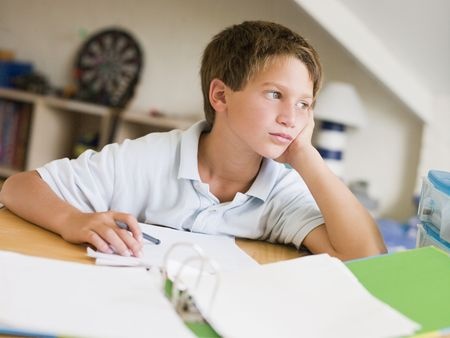Every evening, Johnny sits at the dining table to do his homework. Nearby, the goldfish are frolicking in the fish tank. He watches their bodies glisten as the light hits them.
“That’s fascinating!” he thinks.
He’s intrigued.
He hears them as they forage through the gravel at the bottom… sucking in pebble after pebble and spitting them out.
“Boy, they’re a noisy bunch,” he mutters under his breath.
The table display of velvety fruit calls his hands to caress them. He answers the call and gives in to urge.
It’s really warm in the room. He begins to perspire. The stickiness is making him very uncomfortable so he begins to squirm in his chair. His mind’s eye searches around for something he can fan with.
He jumps up, runs to another room and returns with a card.
“This will work,” he tells himself.
Oh… mom’s cooking dinner. The smells that waft up his nostrils are making him very hungry.
“Ugh! How am I going to last ’til dinner,” he wonders.
He forgets about doing homework. That’s just too much for him now. (It requires too much brain power)
So he slides his favorite comic book inside the middle of his text book and becomes engrossed in it.
Meanwhile, mom thinks he’s doing such a great job working on homework.
Tomorrow will be another episode at school, in the accusation-and-denial homework saga.
Learning is not just about academics… it goes beyond.
EVERYTHING COUNTS!!!
Learning research and studies about the environment indicate that, the environment shapes the learner.
All learning takes place in a physical environment with quantifiable and perceptible physical characteristics.
Consider that
- Whether sitting in a large room in your house, in the backyard under a tree, or in front of a computer screen at their desks, your children are engulfed by environmental information.
- Specific targets within the environment draw the children’s attention – sometimes consciously; other times – unconsciously.
Children do not touch, see, or hear passively.
They feel, look and listen actively.
Wherever they are, children are unable to pay attention to all the environmental information bombarding them, at any given time. They have limited ability to gather and understand all the incoming information.
Consequently, their brains select information for consideration through automatic and controlled processes.
Is the environment in your home conducive to your children’s learning?
Have you created a physical space in which learning can take place without distractions?
Here are 6 tips to optimize learning in your home:
- Determine a set time and place for doing work.
- Make sure there are learning tools in the immediate surroundings – books, writing and drawing equipment, art supplies, everyday objects like boxes, bowls, etc. (Eliminate the need to move out of the room).
- Regulator the temperature so that it does not make your child uncomfortable.
- Control the lighting – some children do better in bright light, others need muted lighting.
- Eradicate strong odors, as well as those that bother your child.
- Remove clutter from the learning space.
The bottom line?
Study your children.
Be a good listener.
Get to know them.
Remember… learning goes beyond academics.
The environment you create in your home can increase your children’s learning potential or detract from it.
The choice is yours.
I talked about the impact of the environment on learning in a conversation with Lucinda Curran, a Healthy Life and Safe Living Consultant in Australia, who integrates Chinese medicine and Building Biology to provide truly holistic healthcare.
Click the video below to listen.


Terrific post and so very true. Those are the guidelines I always give parents about helping their children succeed in school. Granted, there are many more things parents can do to help their children succeed, but first students must have a quiet place at home to study.
Thank you for reiterating that from a parent’s point of view.
Thank you for your support. Yes, these tips are just the beginning points… the framework on which to build.
Hello Flo
Gosh! You get better with every article. Indeed, your physical environment directly affects your ability to process information.
I think this holds true for adults too. As a career-procrastinator (!), I seek to minimize such distractions , but haven’t quite succeeded 😉
You are extremely inspiring, my darling. Your son is blessed #HUGSS.
Please keep writing
Lots of love and TONS OF HUGSSS
Kitto
Thanks, Kitto, for your validation. Knowledge brings with it the power to change.
If I can contribute to making a difference in the life of one child, I will have accomplished something significant.